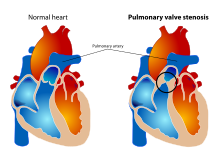Pulmonary stenosis
| Classification according to ICD-10 | |
|---|---|
| Q22.1 | Congenital pulmonary stenosis |
| Q25.6 | Pulmonary artery stenosis (congenital) |
| ICD-10 online (WHO version 2019) | |
The collective term pulmonary stenosis refers to several, mostly congenital, more rarely rheumatic-inflammatory or other processes caused constrictions (stenoses) in the outflow path from the right ventricle to the pulmonary artery (pulmonary artery).
- the infundibular pulmonary stenosis in the muscular lower outflow tract
- the valvular pulmonary stenosis (valvula = small flap) as stenosis of the applied with three pockets pulmonary valve ( pulmonary valve )
- the supravalvular pulmonary stenosis in the main trunk of the pulmonary artery
- the peripheral pulmonary stenoses as stenoses of the pulmonary arteries
Pulmonary stenoses without a ventricular septum defect account for around 10% of all congenital heart defects , with more than 90% of cases being valvular pulmonary stenosis. Infundibular pulmonary stenosis is less common and supravalvular and peripheral stenoses are very rare. Pulmonary stenosis also occurs as part of complex congenital heart defects.
Effects
Valvular pulmonary stenosis is caused by a valve ring that is too narrow and by a malformation of the valve pouches (only two-valve appendix, deformation and thickening of the overgrown valve pouches). In infundibular stenosis, the narrowing of the outflow tract is short, membrane-like or elongated and tubular. The right ventricle (heart chamber) can be divided into two chambers by means of wide muscle bundles . Depending on the tightness of the stenosis, the pressure in the heart chamber increases and the muscle wall becomes stronger. Severe pulmonary stenosis can also lead to right heart failure and dilation of the heart chamber.
Symptoms
Slight stenoses do not cause any symptoms. Moderate stenosis leads to shortness of breath and slight cyanosis of the lips during physical exertion. Severe stenoses cause accelerated breathing and cyanosis even in the resting state, which increase with stress. Then physical development is also impaired.
Diagnosis
- Auscultation and phonocardiography : systolic spindle-shaped expulsion sound over the 2nd intercostal space on the left parasternal (heart base), which can be palpated with a palpable systolic buzzing sound over the heart base ; often widely split 2nd heart sound
- Echocardiography as a non-invasive examination method
- Electrocardiogram (EKG) for diagnosing right heart load
- Cardiac catheters for clarification before operations and to determine the effect of vasodilating substances ( vasodilators )
- Determination of the brain natriuretic peptide concentration of the blood for the detection of heart failure
- MRI , CT , scintigraphy to rule out pulmonary embolism
therapy
Lighter stenoses do not require treatment. Dilatation with a balloon cardiac catheter is now available for moderate and severe stenoses . The replacement of the heart valve is rarely necessary. Artificial heart valves, human valve transplants or bio valves made from animal pericardial tissue can be used as replacement valves. In difficult cases, an operation with a heart-lung machine is performed.
For stenoses caused by vasoconstriction in the lungs, treatment with vasodilators can be performed. This clinical picture is called pulmonary hypertension or pulmonary hypertension.
Eugène Doyen (1859–1916) performed one of the first operations to treat pulmonary stenosis, but it was unsuccessful.
Long term prospects
The long-term prospects for the patients are very good, with the exception of pulmonary hypertension. Nevertheless, lifelong check-ups are indicated. A Endokarditisprophylaxe is according to current guidelines of the German Society of Cardiology unnecessary.
literature
- S2k guideline for valvular pulmonary stenosis of the German Society for Pediatric Cardiology (DGPK). In: AWMF online (as of 2013)
- Klaus Holldack, Klaus Gahl: Auscultation and percussion. Inspection and palpation. Thieme, Stuttgart 1955; 10th, revised edition ibid 1986, ISBN 3-13-352410-0 , pp. 177, 180 and 196 f.
Web links
- University Hospital Bonn, Department of Pediatric Pulmonary Stenosis
Individual evidence
- ^ KL Peterson and J. Ross Junior: "Acquired Heart Valve Defects", in: "Handbook of Internal Diseases", edited by Gerhard Brüschke, Volume 1, Part 2: "Heart, Circulatory and Vascular Diseases", Gustav Fischer Verlag , Stuttgart 1986 , ISBN 3-437-10968-5 , page 281.
- ↑ Ferdinand Sauerbruch : Surgical interventions on the heart [for heart diseases]. Lecture given in London in 1937. In: Ferdinand Sauerbruch, Hans Rudolf Berndorff : That was my life. Kindler & Schiermeyer, Bad Wörishofen 1951; cited: Licensed edition for Bertelsmann Lesering, Gütersloh 1956, pp. 368–385, here: p. 374.
